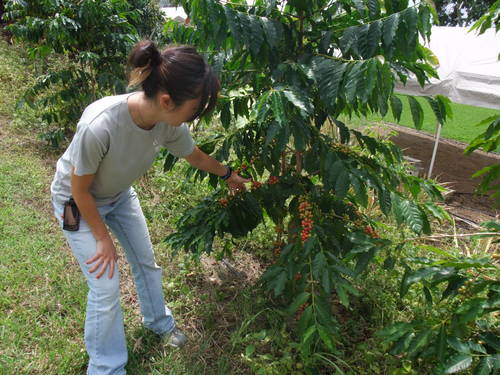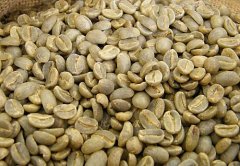How much do you know about Hawaii Kona Coffee-UCC Coffee Farm Record Hawaii Kona Coffee Origin Information

Professional coffee knowledge exchange more coffee bean information please follow the coffee workshop (Wechat official account cafe_style)
Learn first-hand about the coffee making process and various Hawaiian delicacies at Greenwell Farm in Kona Coffee area.
At first, it was just because my brother said, "remember to send me a bag of kona coffee when you go to Hawaii!" So pay close attention to the origin and information of kona coffee.
But when I got here, I was surprised that it was so convenient to buy kona coffee. Walmart shelves are full of all kinds of KONA coffee, and the price is not too high (8oz ranges from $6 to $10). I don't know where the differences are, and the whole thing makes me dazzle.
I want to buy two bags that look more advanced and send them home, but Dad said that this price can actually be bought in Taiwan, and it seems that there is no need to send a special airmail parcel back, which inspires me to go to KONA to look for "legendary coffee beans".
So we found travel books and booked a trip to the coffee garden online (free). We went to ↓↓↓, the only farm of the famous coffee company UCC in KONA.
The farm is on the hill of KONA, and we drive all the way to "is this really the place? is there a kind of coffee here?" The doubt, because it is really a little desolate, and even floating up the light rain!
After walking around the mountain, we finally found the coffee farm, and our boss, who met us head on, spoke a lot of Japanese to us (laughter) and we had to giggle back "We're Taiwanese!"
There is a tasting and selling vendor at the entrance to greet us.
The boss specially recommended one of the coffee beans, "Peaberry". I checked that Taiwan should be called "public beans". Public beans are also the most famous for the variety of KONA coffee, pure public beans are not easy to buy in supermarkets, because the output accounts for only 5% of all coffee beans and is usually purchased in stores near the origin. Isn't this the coffee bean that I ideally send home will have a lot of face!
After we tried it, although I have a clumsy tongue and can't tell whether the coffee is good or bad, I'm sure Peaberry is really good, because pure black coffee without sugar and cream is smooth, bitter and sour, and I, who usually add sugar and milk, can also drink it directly. The taste is indeed different from other KONA coffee, and it is very suitable for people who like to taste it.
The lovely commentator (married) took us to the hillside behind the vendor and began to introduce coffee trees to us. I think I'll just write down what I heard based on my impression ^ _ ^
Coffee beans grow in a period of time, and the places that have grown this year will not grow again next year, so the branches will grow longer and longer, one at a time, and of course they will mop the floor when they grow a long time. So the whole tree is cut down about every five or six years, but the roots are reserved for it to grow again.
Coffee trees don't really need to be taken care of. KONA Coffee is famous because it is only suitable for growing coffee in the "certain mountain area" of KONA. Partly because of the volcanic soil properties of Hawaii, and partly because of the wonderful weather in KONA, which is sunny during the day but showers begin after noon, these coffee trees can grow well without watering! In addition, kona coffee actually uses the same Arabica tree species as Blue Mountain coffee, but it has a completely different flavor because of its different climate, altitude and soil.
You can see that the whole bunch of coffee beans are red and green, but only the very dark red ones can be harvested. So the hard part of growing coffee beans is that they must be harvested one by one artificially and then baked and baked in the sun. The coffee season is between July, August and January every year (I'm not sure if I remember correctly), and the annual output of a whole coffee tree. Only one pound of coffee beans! (about 50 cups of coffee)
In terms of the output of UCC Farm, a total of more than 10,000 coffee trees are planted, but because they have to be cut down in turn to allow them to grow again, the actual number of coffee beans that can be produced each year is about 7,000 to 8,000 trees, so the annual output of coffee beans is about 7,000 to 8,000 pounds.
I remember a few days before we went to KONA, the king asked me whether a whole fruit is equal to a coffee bean, or are there many seeds in the fruit? We got the answer on this day, ↓↓↓.
Yes, generally speaking, the seeds are two coffee beans, that is, the most common coffee beans. If it's Peaberry, it's a whole bean. It won't split in half. In fact, Peaberry is due to special conditions (pests or planting defects) caused by abnormal beans, the appearance will be slightly smaller than the ordinary, but it is impossible to determine whether it is a male bean or a mother bean without pulling it apart!
We put coffee beans directly in our mouths. Surprisingly, they are sweet. If he had more flesh, it might be a good fruit (laughter)! Unfortunately, the pulp has only a thin layer of skin, and it is not enough to plug the teeth!
I went to the Internet to catch the difference between soybeans and soybeans. There is Peaberry on the left and common soybeans on the right. In fact, the Chinese translation has the misleading feeling that beans are all picked from the same tree and have nothing to do with biological sex.
In addition, the difference in color depends on the degree of baking. The darker it is, of course, the longer it is roasted, and the caffeine in coffee beans will gradually lose with the baking time, and the more bitter it will be. The farm uses moderate city roast, which is said to be the most drinkable grade.
Of course, the farm also has some ancillary products, he gave each of us a box of trial chocolate beans, this chocolate is a package of complete coffee beans! Super delicious (thumb)
As a result, we all lost a few bags of coffee beans. I bought two bags of Peaberry Kona Coffee and coffee chocolate beans to send back to my family. As the freight is expensive, if any other Taiwanese friends want it, please wait until next summer vacation to talk about XD. I will try to stuff a lot of it into my suitcase and bring it back to Taiwan! After all, the freight on this island is 1/6 of the international freight.
In terms of the price of coffee beans, the price of regular KONA coffee on this farm is $15.75 for 8oz USD and $19.00 for Peaberry, which is twice as expensive as the parity coffee I saw in walmart. Ah Chun unexpectedly bought a bag of Peaberry to cook himself to drink, super luxury! It makes me want to order a few bags with the farm on the Internet and drink one for myself. "(I'm a good boy, I cook cheap brand drinks).
This time the kona line is very happy, we have played what we should play, we have bought what we should buy, and we have learned what we should learn! Ya!
.
Important Notice :
前街咖啡 FrontStreet Coffee has moved to new addredd:
FrontStreet Coffee Address: 315,Donghua East Road,GuangZhou
Tel:020 38364473
- Prev

What's the taste of mocha? what's the meaning of mocha?
Professional coffee knowledge exchange more coffee bean information please pay attention to the coffee workshop (Wechat official account cafe_style) the difference between mocha and Italian mocha coffee flavor and characteristics mocha coffee is equal to milk and chocolate mixed in Italian latte mocha coffee (English: Caf Mocha, Italian: Mocaccino, also known as mocha or mocha) is Italian
- Next

Hawaii Kona Coffee Hawaii 100% Kona Coffee beans Kona Coffee Brand
Professional coffee knowledge exchange more coffee bean information please follow the coffee workshop (Wechat official account cafe_style) first-hand understanding of the coffee production process and all kinds of Hawaiian cuisine at Greenville Farm in Kona Coffee area. Hawaii is a beautiful island that began to grow coffee in the 18th century. Most of the coffee is grown on Kauai Island and the Big Island of Hawaii, with an ideal climate.
Related
- Detailed explanation of Jadeite planting Land in Panamanian Jadeite Manor introduction to the grading system of Jadeite competitive bidding, Red bid, Green bid and Rose Summer
- Story of Coffee planting in Brenka region of Costa Rica Stonehenge Manor anaerobic heavy honey treatment of flavor mouth
- What's on the barrel of Blue Mountain Coffee beans?
- Can American coffee also pull flowers? How to use hot American style to pull out a good-looking pattern?
- Can you make a cold extract with coffee beans? What is the right proportion for cold-extracted coffee formula?
- Indonesian PWN Gold Mandrine Coffee Origin Features Flavor How to Chong? Mandolin coffee is American.
- A brief introduction to the flavor characteristics of Brazilian yellow bourbon coffee beans
- What is the effect of different water quality on the flavor of cold-extracted coffee? What kind of water is best for brewing coffee?
- Why do you think of Rose Summer whenever you mention Panamanian coffee?
- Introduction to the characteristics of authentic blue mountain coffee bean producing areas? What is the CIB Coffee Authority in Jamaica?

